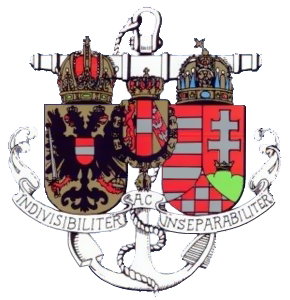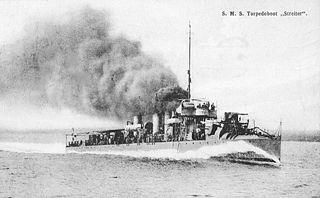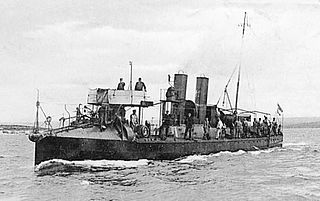Related Research Articles

Pula, also known as Pola, is the largest city in Istria County, Croatia, and the seventh-largest city in the country, situated at the southern tip of the Istrian peninsula in northwestern Croatia, with a population of 52,220 in 2021. It is known for its multitude of ancient Roman buildings, the most famous of which is the Pula Arena, one of the best preserved Roman amphitheaters. The city has a long tradition of wine making, fishing, shipbuilding, and tourism. It was the administrative centre of Istria from ancient Roman times until superseded by Pazin in 1991.

The Tegetthoff class was a class of four dreadnought battleships built for the Austro-Hungarian Navy. Named for Austrian Admiral Wilhelm von Tegetthoff, the class was composed of SMS Viribus Unitis, SMS Tegetthoff, SMS Prinz Eugen, and SMS Szent István. Construction started on the ships shortly before World War I; Viribus Unitis and Tegetthoff were both laid down in 1910, Prinz Eugen and Szent István followed in 1912. Three of the four warships were built in the Stabilimento Tecnico Triestino shipyard in Trieste; Szent István was built in the Ganz-Danubius shipyard in Fiume, so that both parts of the Dual Monarchy would participate in the construction of the ships. The Tegetthoff-class ships hold the distinction for being the first and only dreadnought battleships of the Austro-Hungarian Navy. The SMS Szent István had a different more modern propulsion system than her sister ships.

SMS Szent István was the last of four Tegetthoff-class dreadnought battleships built for the Austro-Hungarian Navy. Szent István was the only ship of her class to be built within the Hungarian part of the Austro-Hungarian Empire, a concession made to the Hungarian government in return for its support for the 1910 and 1911 naval budgets which funded the Tegetthoff class. She was built at the Ganz-Danubius shipyard in Fiume, where she was laid down in January 1912. She was launched two years later in 1914, but Szent István's construction was delayed due to the smaller shipyards in Fiume, and further delayed by the outbreak of World War I in July 1914. She was finally commissioned into the Austro-Hungarian Navy in December 1915.

The Austro-Hungarian Navy or Imperial and Royal War Navy was the naval force of Austria-Hungary. Ships of the Austro-Hungarian Navy were designated SMS, for Seiner Majestät Schiff. The k.u.k. Kriegsmarine came into being after the formation of Austria-Hungary in 1867, and ceased to exist in 1918 upon the Empire's defeat and subsequent collapse at the end of World War I.

SMS Viribus Unitis was an Austro-Hungarian dreadnought battleship, the first of the Tegetthoff class. "Viribus Unitis", meaning "With United Forces", was the personal motto of Emperor Franz Joseph I.

SMS Prinz Eugen was the third of four Tegetthoff-class dreadnought battleships built for the Austro-Hungarian Navy. Prinz Eugen was named for Prince Eugene of Savoy, a Habsburg general and statesman during the 17th and 18th centuries most notable for defeating the Ottoman Empire at the Battle of Zenta in 1697. The ship was armed with a main battery of twelve 30.5 cm (12.0 in) guns in four triple turrets. Constructed shortly before World War I, she was built at the Stabilimento Tecnico Triestino shipyard in Trieste, where she was laid down in January 1912 and launched in November that same year.

The U-1 class was a class of two submarines or U-boats built for and operated by the Austro-Hungarian Navy. The class comprised U-1 and U-2. The boats were built to an American design at the Pola Navy Yard after domestic design proposals failed to impress the Navy. Constructed between 1907 and 1909, the class was a part of the Austro-Hungarian Navy's efforts to competitively evaluate three foreign submarine designs.

SM U-1 or U-I was the lead boat of the U-1-class of submarines or U-boats built for and operated by the Austro-Hungarian Navy. U-1 was designed by American naval architect Simon Lake of the Lake Torpedo Boat Company, and constructed at the Navy Yard in Pola. She was one of two Lake-designed submarines purchased as part of a competitive evaluation of foreign submarine designs after domestic proposals were rejected by the Navy.

SM U-2 or U-II was the second ship of the U-1 class of submarines or U-boats built for and operated by the Austro-Hungarian Navy. U-2 was designed by American naval architect Simon Lake of the Lake Torpedo Boat Company, and constructed at the navy yard in Pola. She was one of two Lake-designed submarines purchased as part of a competitive evaluation of foreign submarine designs after domestic proposals were rejected by the Navy.
SM U-41 or U-XLI was a U-27 class U-boat or submarine for the Austro-Hungarian Navy. U-41, built by the Austrian firm of Cantiere Navale Triestino (CNT) at the Pola Navy Yard, was launched in November 1917. When she was commissioned in February 1918, she became the last boat of her class to enter service. She was also the last domestically constructed Austro-Hungarian U-boat to enter service.
Cantiere Navale Triestino – abbreviated CNT, or in English Trieste Naval Shipyard – was a private shipbuilding company based at Monfalcone operating in the early 20th century. The yard still functions today, though under a different name.

T1 was a seagoing torpedo boat that was operated by the Royal Yugoslav Navy between 1921 and 1941. Originally 76 T, a 250t-class torpedo boat of the Austro-Hungarian Navy built in 1914, she was armed with two 66 mm (2.6 in) guns and four 450 mm (17.7 in) torpedo tubes, and could carry 10–12 naval mines. She saw active service during World War I, performing convoy, escort and minesweeping tasks, anti-submarine operations and shore bombardment missions. In 1917 the suffixes of all Austro-Hungarian torpedo boats were removed, and thereafter she was referred to as 76. She was part of the escort force for the Austro-Hungarian dreadnought Szent István during the action that resulted in the sinking of that ship by Italian torpedo boats in June 1918.

The Huszár class was a class of destroyers built for the Austro-Hungarian Navy before the First World War. They were built to a design by the British shipbuilder Yarrow Shipbuilders, who built the first ship, with a further 11 ships being built in Austrian and Hungarian yards between 1905 and 1909. A replacement ship was built when the lead ship was lost in an accident in 1908, and another ship of similar design building for the Chinese navy was seized on the outbreak of the First World War. Two ships were lost during the war, a single ship serving with the Greek Navy following the end of the war, and the remainder being scrapped.

The Kaiman class were high-seas torpedo boats built for the Austro-Hungarian Navy between 1904 and 1910. A total of 24 boats were built by three shipbuilding companies. Yarrow Shipbuilders built the lead ship, Stabilimento Tecnico Triestino of Trieste built 13 boats, and Ganz-Danubius constructed the remaining 10 boats at their shipyards at Fiume. The class was considered to be a successful design, and all boats saw extensive active service during World War I, undertaking a range of tasks, including escort duties, shore bombardments, and minesweeping. All survived, although several were damaged by naval mines and collisions. One was torpedoed and badly damaged by a French submarine, and two sank an Italian submarine. All the boats were transferred to the Allies and scrapped at the end of the war, except for four that were allocated to the navy of the newly created Kingdom of Serbs, Croats and Slovenes. These were discarded and broken up between 1928 and 1930.

T7 was a sea-going torpedo boat operated by the Royal Yugoslav Navy between 1921 and 1941. Originally 96 F, a 250t-class torpedo boat of the Austro-Hungarian Navy built in 1915–1916, she was armed with two 66 mm (2.6 in) guns and four 450 mm (17.7 in) torpedo tubes, and could carry 10–12 naval mines. She saw active service during World War I, performing convoy escort, patrol, and minesweeping tasks, and anti-submarine operations. In 1917 the suffixes of all Austro-Hungarian torpedo boats were removed, and thereafter she was referred to as 96.

T6 was a sea-going torpedo boat that was operated by the Royal Yugoslav Navy between 1921 and 1941. Originally 93 F, a 250t-class torpedo boat of the Austro-Hungarian Navy built in 1915–1916, she was armed with two 66 mm (2.6 in) guns and four 450 mm (17.7 in) torpedo tubes, and could carry 10–12 naval mines. She saw active service during World War I, performing convoy, escort, patrol and minesweeping tasks, and anti-submarine operations. In 1917 the suffixes of all Austro-Hungarian torpedo boats were removed, and thereafter she was referred to as 93.

T2 was a seagoing torpedo boat operated by the Royal Yugoslav Navy between 1923 and 1939. Originally 77 T, a 250t-class torpedo boat of the Austro-Hungarian Navy built in 1914, she was armed with two 66 mm (2.6 in) guns and four 450 mm (17.7 in) torpedo tubes, and could carry 10–12 naval mines. She saw active service during World War I, performing convoy, patrol, escort, minesweeping and minelaying tasks, anti-submarine operations, and shore bombardment missions. In 1917, the suffixes of all Austro-Hungarian torpedo boats were removed, and thereafter she was referred to as 77. Present in the Bocche di Cattaro during the short-lived mutiny by Austro-Hungarian sailors in early February 1918, members of her crew raised the red flag but undertook no other mutinous actions. 77 was part of the escort force for the Austro-Hungarian dreadnought Szent István during the action that resulted in the sinking of that ship by Italian torpedo boats in June 1918.

T4 was a seagoing torpedo boat operated by the Royal Yugoslav Navy between 1921 and 1932. Originally 79 T, a 250t-class torpedo boat of the Austro-Hungarian Navy built in 1914, she was armed with two 66 mm (2.6 in) guns and four 450 mm (17.7 in) torpedo tubes, and could carry 10–12 naval mines. She saw active service during World War I, performing convoy, patrol, escort and minesweeping tasks, anti-submarine operations and shore bombardment missions. In 1917 the suffixes of all Austro-Hungarian torpedo boats were removed, and thereafter she was referred to as 79. Underway during the short-lived mutiny by Austro-Hungarian sailors in early February 1918, her captain realised the danger and put her crew ashore. She was part of the escort force for the Austro-Hungarian dreadnought Szent István during the action that resulted in the sinking of that ship by Italian torpedo boats in June 1918.

SMS Natter was a torpedo boat of the Austro-Hungarian Navy. Natter was built by the German shipbuilder Schichau-Werke between 1895 and 1896. She was renamed Torpedoboot 18 in 1910 and used for local coast defence during the First World War. She was scrapped in 1920.

The 110t class were a class of twelve coastal torpedo boats built for the Austro-Hungarian Navy between 1909 and 1911. They were built by two shipbuilders, the Austrian Stabilimento Tecnico Triestino and the Hungarian Ganz & Danubius, with six ships built each. They served through the First World War, with one of the ships, Tb 11, defecting to Italy in 1917. After the end of the war, several of the class were used by the Italian Navy and the Italian Customs Service, with the last example scrapped in 1926.
References
- ↑ ellis, dan. "Profiles". delisle.passchristian.net.
- ↑ "(E) Martinolich Shipyards in America". www.croatia.org.
- ↑ Torp, K. "Biographies - Harrison County Mississippi Genealogy Trails". genealogytrails.com.